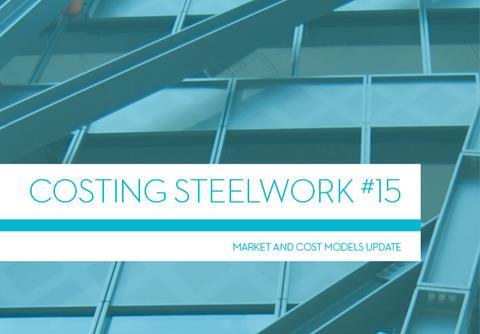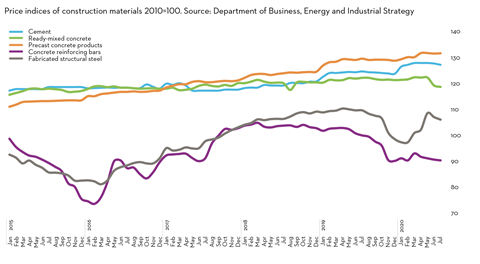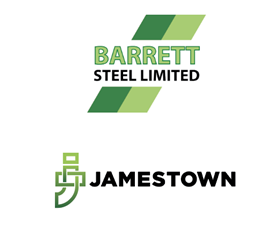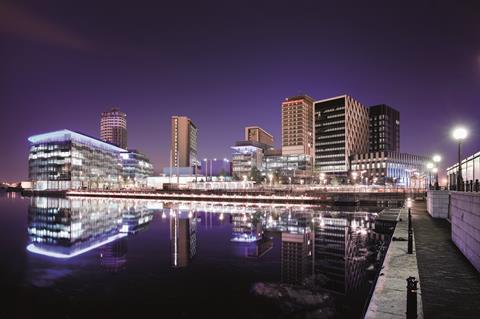Costing Steelwork is a series from Aecom, BCSA and Steel for Life that provides guidance on costing structural steelwork. This quarter provides a market update and updates the five cost models previously featured in Costing Steelwork

Many UK business sentiment indicators recorded historical lows, by some way, at the nadir of the pandemic lockdown. Many of these indicators stretch back decades, underscoring the extraordinary impacts of this period. Economic momentum immediately prior to the coronavirus pandemic was weaker than the 2019 trend, and may have already started to contract going into 2020.
The UK’s GDP yearly growth rate at Q2 2020 fell precipitously, recording its largest ever fall at -21.5%. Adding this to the negative Q1 2020 rate of change put the UK officially into recession. Subdued consumer sentiment and excess precautionary saving was a strong theme during the lockdown period, and this on-going trend will continue to act as a drag on economic activity in the UK. Similarly, uncertainty dents business confidence, and with it the likelihood of proceeding with capital investment. For there to be substantial levels of construction activity relies on private sector confidence and its investment. Some projects have been paused as a result of the economic turbulence, and further consequences for workload can be expected should uncertainty linger.
Although construction output momentum has been knocked back, there remain promising levels of optimism about workload through into 2021. This is not a uniform picture, though, and much relates to a firm’s exposure to economic sectors. Still, UK construction output is posting increasingly positive data points since the slump in Q2 2020. The yearly rate of change is still negative at -13%, but this is a significant improvement from the low of -45.9% in April. This rebound in activity is relatively strong, particularly given that the shutdown impacts were so large. As more sites reopened, extended working hours aided productivity to offset social distancing measures that acted as a drag to more efficient working. A number of soft data indicators also show an improvement in construction industry sentiment. However, work backlog, employment outlook and underlying demand, once the V-shaped bounce-back dissipates, warn of the potential for downside risks further out.
Above-average building cost inflation continues across several materials classifications. Aecom’s composite index for building costs – comprised of materials and labour inputs – fell by 1.9% over the year to Q3 2020. A significant majority of materials classes in the index showed a rise in cost, or no change, between Q2 and Q3 2020. This is a response to a combination of restart demand, some enduring lockdown constraints, and low inventories conspiring to create tight supply conditions for these materials. It is unclear whether this is predominantly because of domestic or import issues. Similarly, wages grew strongly from the past quarter, as demand for labour returned with site activity.
Tender prices remain broadly unchanged on a year-to-year basis at Q3 2020. This is the slowest pace of tender price inflation for two years. Lower prevailing rates for preliminaries and other on-cost items contributed to this more gradual level of price inflation. The lockdown will have some effect on market pricing, but future pricing trends will also be affected by any sustained period of lower overall construction activity.
External factors will influence pricing decisions. The pandemic has introduced significant headwinds. Commercial pressures are marked from a combination of matching cost bases to predicted work volumes, and whether higher prices can be secured for tendered work. Margins had held up or improved in recent years for parts of the supply chain, but renewed pressure is expected from the confluence of a unique set of circumstances. Indeed, financial statements released by supply chain firms all highlight the risks to future revenues, if they have not already materialised, and expected impacts to margins.
How can this current rebound turn into a sustained recovery? Counter-cyclical government policies are possible, to offset falls in aggregate demand and related private sector-led investment. Private investment often correlates to prevailing uncertainty. Construction can be used to pump-prime economies with shovel-ready projects in recessionary times. Policy stimulus for housing, as in 2013, is likely but the efficacy of this will be influenced by how the lockdown has impacted personal finances. Trade-offs around public finances mean it is not guaranteed whether public sector capital investment will make up all of the deficit from any falls in private sector demand. However, the public sector will be increasingly seen as a source of steadier workload for construction firms over the next couple of years.
Sourcing cost information
Cost information is generally derived from a variety of sources, including similar projects, market testing and benchmarking. Due to the mix of source information it is important to establish relevance, which is paramount when comparing buildings in size, form and complexity.
Figure 3 represents the costs associated with the structural framing of a building, with a BCIS location factor of 100 expressed as a cost/m² on GIFA. The range of costs represents variances in the key cost drivers. If a building’s frame cost sits outside these ranges, this should act as a prompt to interrogate the design and determine the contributing factors.
The location of a project is a key factor in price determination, and indices are available to enable the adjustment of cost data across different regions. The variances in these indices, such as the BCIS location factors (figure 4), highlight the existence of different market conditions in different regions.
Figure 1: Material price trends

Figure 2: Tender price inflation, Aecom Tender Price Index, 2015=100
| Forecast* | |||||||
|---|---|---|---|---|---|---|---|
|
Quarter |
2017 |
2018 |
2019 |
2020 |
2021 |
2022 |
2023 |
|
1 |
110.9 |
113.2 |
117.9 |
120.4 |
– |
– |
– |
|
2 |
111.3 |
113.6 |
118.3 |
120.4 |
– |
– |
– |
|
3 |
112.2 |
115.4 |
119.3 |
120.4 |
– |
– |
– |
|
4 |
112.6 |
117.3 |
120.0 |
– |
– |
– |
– |
* Meaningful forecasts are not possible at this time on the basis that the short- to medium-term impact of the covid-19 pandemic on the industry is unknown.
Figure 3: Indicative cost ranges based on gross internal floor area
| TYPE | Base index 100 (£/m2) | Notes |
|---|---|---|
|
Frames |
||
|
Steel frame to low-rise building |
102-124 |
Steelwork design based on 55kg/m2 |
|
Steel frame to high-rise building |
171-193 |
Steelwork design based on 90kg/m2 |
|
Complex steel frame |
193-228 |
Steelwork design based on 110kg/m2 |
|
Floors |
||
|
Composite floors, metal decking and lightweight concrete topping |
62-95 |
Two-way spanning deck, typical 3m span with concrete topping up to 150mm |
|
Precast concrete composite floor with concrete topping |
102-144 |
Hollowcore precast concrete planks with structural concrete topping spanning between primary steel beams |
|
Fire protection |
||
|
Fire protection to steel columns and beams (60 minutes resistance) |
15-20 |
Factory applied intumescent coating |
|
Fire protection to steel columns and beams (90 minutes resistance) |
17-29 |
Factory applied intumescent coating |
|
Portal frames |
||
|
Large-span single-storey building with low eaves (6-8m) |
75-98 |
Steelwork design based on 35kg/m2 |
|
Large-span single-storey building with high eaves (10-13m) |
86-119 |
Steelwork design based on 45kg/m2 |
Figure 4: BCIS location factors, as at Q4 2019
| Location | BCIS Index | Location | BCIS Index |
|---|---|---|---|
|
Central London |
127 |
Nottingham |
104 |
|
Manchester |
99 |
Glasgow |
93 |
|
Birmingham |
96 |
Newcastle |
92 |
|
Liverpool |
94 |
Cardiff |
94 |
|
Leeds |
93 |
Dublin |
96* |
*Aecom index
Steel For Life sponsors
Headline

Gold
Ficep UK Ltd, National Tube Stockholders and Cleveland Steel & Tubes, Peddinghaus Corporation, voestalpine Metsec plc, Wedge Group Galvanizing Ltd
Silver
Jack Tighe Ltd, Kaltenbach Ltd, Tata Steel, Trimble Solutions (UK) Ltd
Cost comparison updates
This quarter’s Costing Steelwork provides an update of the five previously featured cost comparisons covering: offices, education, industrial, retail and mixed-use
These five projects were originally part of the Target Zero study conducted by a consortium of organisations including Tata Steel, Aecom, SCI, Cyril Sweett and the BCSA in 2010 to provide guidance on the design and construction of sustainable, low- and zero-carbon buildings in the UK. The cost models for these five projects have been reviewed and updated as part of the Costing Steelwork series. The latest cost models as of Q1 2020 are presented here.

Costing steelwork: offices update
Below is an update to the offices cost comparison originally published in the Costing Steelwork Offices feature in �ڶ����� magazine in April 2017.
One Kingdom Street, London, key features
- 10 storeys, with two levels of basement
- Typical clear spans of 12m x 10.5m
- Three cores – one main core with open atrium, scenic atrium bridges and lifts
- Plant at roof level
Cost comparison
Two structural options for the office building were assessed (as shown in figure 5):
- Base case – a steel frame, comprising fabricated cellular steel beams supporting a lightweight concrete slab on a profiled steel deck
- Option 1 – 350mm-thick post-tensioned concrete flat slab with a 650mm x 1,050mm perimeter beam.
The full building cost plans for each structural option have been reviewed and updated to provide current costs at Q3 2020. Movement has continued to be relatively static from Q2 2020. The costs, which include preliminaries, overheads, profit and a contingency, are summarised in figure 5.
The cost of the steel composite solution is 7% lower than that for the post-tensioned concrete flat slab alternative for the frame and upper floors, and 5% lower on a total building basis.
Figure 5: Key costs £/m² (GIFA), for City of London office building
| Elements | Steel composite | Post-tensioned concrete flat slab |
|---|---|---|
|
Substructure |
89 |
95 |
|
Frame and upper floors |
442 |
476 |
|
Total building |
2,665 |
2,798 |
Costing steelwork: education update
Below is an update to the education cost comparison originally published in the Costing Steelwork Education feature in �ڶ����� magazine in July 2017.
Christ the King Centre for Learning, Merseyside, key features
- Three storeys, with no basement levels
- Typical clear spans of 9m x 9m
- 591m2 sports hall (with glulam frame), 770m2 activity area and atrium
- Plant at roof level
Cost comparison
Three structural options for the building were assessed (as shown in figure 6), which include:
- Base case – steel frame, 250mm hollowcore precast concrete planks with 75mm structural screed
- Option 1 – in situ 350mm reinforced concrete flat slab with 400mm x 400mm columns
- Option 2 – steel frame, 130mm concrete topping on structural metal deck.
The full building cost plans for each option have been updated to provide current costs at Q3 2020. The comparative costs highlight the importance of considering total building cost when selecting the structural frame material.
The concrete flat slab option has a marginally lower frame and floor cost compared with the steel composite option, but on a total-building basis, the steel composite option has a lower overall cost £3,159/m2 against £3,185/m2. This is because of lower substructure and roof costs, alongside lower preliminaries resulting from the shorter programme.
Figure 6: Key costs £/m² (GIFA), for Merseyside secondary school
| Elements | Steel + precast hollow-core planks | In situ concrete flat slab | Steel composite |
|---|---|---|---|
|
Frame and upper floors |
294 |
254 |
267 |
|
Total building |
3,216 |
3,185 |
3,159 |
Costing steelwork: industrial update
Below is an update to the industrial cost comparison originally published in the Costing Steelwork Industrial feature in �ڶ����� magazine in October 2017.
Distribution warehouse in ProLogis Park, Stoke-on-Trent, key features
- Warehouse: four-span, steel portal frame, with a net internal floor area of 34,000m2
- Office: 1,400m2, two-storey office wing with a braced steel frame with columns
Cost comparison
Three frame options were considered:
- Base option – a steel portal frame with a simple roof solution
- Option 1 – a hybrid option: precast concrete column and glulam beams with timber rafters
- Option 2 – a steel portal frame with a northlight roof solution.
The full building cost plans for each option have been updated to provide costs at Q3 2020. The steel portal frame provides optimum build value at £691/m2; glulam is least cost-efficient. This is primarily due to the cost premium for the structural members necessary to provide the required spans, which are otherwise efficiently catered for in the steelwork solution.
With a hybrid, the elements are from different suppliers, which raises the cost. The northlights option is directly comparable with the portal frame in relation to the warehouse and office frame. The variance is in the roof framing as the northlights need more. Other additional costs relate to the glazing of the northlights.
Figure 7: Key costs £/m2 (GIFA), for Stoke-on-Trent distribution warehouse
| Elements | Steel portal frame | Glulam beams + purlins + concrete columns | Steel portal frame + north-lights |
|---|---|---|---|
|
Warehouse |
71 |
144 |
84 |
|
Office |
131 |
173 |
131 |
|
Total frame |
75 |
145 |
88 |
|
Total building |
691 |
774 |
743 |
Costing steelwork: retail update
Below is an update to the retail cost comparison originally published in the Costing Steelwork retail feature in �ڶ����� magazine in January 2018.
Asda food store, Stockton-on-Tees,
key features
- Total floor area of 9,393m2
- Retail area based on 12m x 12m structural grid
Cost comparison
Three frame options were considered (as shown in figure 8) to establish the optimum solution for the building, as follows:
- Base option – a steel portal frame on
CFA piles
- Option 1 – glulam timber rafters and columns on CFA piles
- Option 2 – a steel portal frame with a northlight roof solution on driven steel piles.
The full building cost plans for each option have been updated to provide costs at Q3 2020. The steel portal frame provides the optimum build value at £2,629/m2, with the glulam option the least cost-efficient. The greater cost is due to the direct comparison of the steel frame solution against the glulam columns and beams/ rafters. A significant proportion of the building cost is in the M&E services and fit-out elements, which reduce the impact of the structural changes.
The northlights option is directly comparable with the portal frame in relation to the main supermarket – the variance is in the roof framing as the northlights require more. Additional costs beyond the frame are related to the glazing of the northlights and the overall increase in relative roof area.
Figure 8: Key costs £/m2 (GIFA), for Stockton-on-Tees food store
| Elements | Steel portal frame | Glulam timber rafters + columns | Steel portal frame + north-lights |
|---|---|---|---|
|
Structural unit cost |
145 |
177 |
163 |
|
Total building unit cost |
2,629 |
2,669 |
2,639 |
Costing steelwork: mixed-use update
Below is an update to the mixed-use cost comparison originally published in the Costing Steelwork mixed-use focus feature in �ڶ����� magazine in April 2018.
Holiday Inn tower, MediaCityUK, Manchester
- 17-storey tower
- 7,153m2 of open-plan office space on five floors (floors two to six)
- 9,265m2 of hotel space on eight floors (floors eight to 15)
The gross internal floor area of the building is 18,625m2. The 67m-high building is rectilinear with approximate dimensions of 74m x 15.3m.
Cost comparison
Three frame options were considered to establish the optimum solution for the building:
- Base option – steel frame with Slimdek floors
- Option 1 – concrete flat slab
- Option 2 – composite deck on cellular beams (offices) and UCs used as beams (hotel).
The full building cost plans for each option have been updated to provide costs at Q3 2020. The steel frame with composite deck continues to provide the optimum build value, with the overall building cost at £2,600/m2.
Options 1 and 2 are arguably more typical for this building type. The base case structure is an unusual solution due to a decision to change the residential accommodation to office floors at a very late stage – time constraints precluded redesign of the tower block, hence the original Slimdek design was constructed.
Figure 9: Key costs £/m2 (GIFA), for hotel/office building in Manchester
| Elements | Steel frame with Slimdek | Concrete flat slab | Composite deck on cellular beams (offices) and UCs used as beams (hotel) |
|---|---|---|---|
|
Structural unit cost |
518 |
433 |
354 |
|
Total building unit cost |
2,809 |
2,705 |
2,600 |
This Costing Steelwork article produced by Patrick McNamara (director) and Michael Hubbard (associate) of Aecom is available at .
The data and rates contained in this article have been produced for comparative purposes only and should not be used or relied upon for any other purpose without further discussion with Aecom. Aecom does not owe a duty of care to the reader or accept responsibility for any reliance on the article contents.



























No comments yet